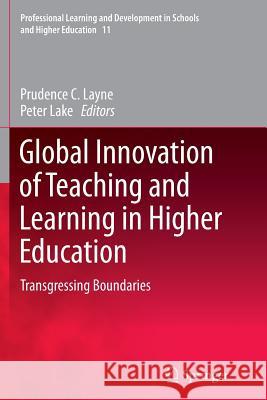Global Innovation of Teaching and Learning in Higher Education: Transgressing Boundaries » książka



Global Innovation of Teaching and Learning in Higher Education: Transgressing Boundaries
ISBN-13: 9783319382340 / Angielski / Miękka / 2016 / 369 str.
Global Innovation of Teaching and Learning in Higher Education: Transgressing Boundaries
ISBN-13: 9783319382340 / Angielski / Miękka / 2016 / 369 str.
(netto: 191,66 VAT: 5%)
Najniższa cena z 30 dni: 192,74
ok. 22 dni roboczych
Dostawa w 2026 r.
Darmowa dostawa!
This book examines current trends in higher education and the Scholarship of Teaching and Learning.
Wydanie ilustrowane
Foreword.- Preface.- Introduction.- Teaching & Learning at the Crossroads. By Prudence Layne & Peter Lake.- Transforming the “Traditional” in Higher Education.- Concentrated Learning: A Linear Approach to Knowledge for Higher Education by John Baun.- Transforming Higher Education Institutions by Prudence Layne.- Digital Storytelling in Industrial Design by Veronica Barnes, Daniela Gachago & Eunice Ivala.- Challenging Pedagogic Norms: Engaging First-Year Undergraduates in an Intensive, Research-Informed Learning Programme by Sue Burkill.- Trickery and Performativity: Innovations in Assessment in the History Discipline in Australian Universities by Adele Nye.- Global Innovations in Teaching and Learning.- Pre-Service Teachers and Study Abroad: A Reflective, Experiential Sojourn to Increase Intercultural Competence and Translate the Experience into Culturally Relevant Pedagogy by Katie Roller.- Student Teaching Abroad: Intercultural Learning in Context and a Changing Approach to U.S. Educator Preparation by Opal Leeman Bartzis & Thalia M. Mulvihill.- Navigating the Performing Arts in a Globally-Networked Classroom: The Case of Jazz! Born in America, Created Internationally by Lenora Z. Helm & Emmanuel Oritsejafor.- Transgressing Boundaries Using Technology.- The Course as Container: Distributed Learning and the MOOC by Sean Michael Morris & Jesse Stommel.-The Efficacy of LSA (Variant) -Based Feedback for Assessing Student Learning in an Introductory International Relations Course by D. Roman Kulchitsky, Amir Zeid & Ahmed M. Hamza.- Can Technological Code-switching be Taught: Utilizing Twitter as a Communication Tool by Abigail Grant Scheg.- Conflict in Online Learning by David Mathew.- Restructuring Delivery, Formats & Modes.- What’s an Instructor to Do? by Royce Ann Collins.- A Review of a Short, Sharp Pilot in a Computing MSc by Peter Lake.- Active Student Engagement: The Heart of Effective Learning by Rebecca Strachan & Lalith Liyanage.- Learning in Three Dimensions: Using Lego Serious Play for Creative and Critical Reflection Across Time and Space by Alison James.- ‘Flipping’ the Postgraduate Classroom: Supporting the Student Experience by Sara Smith, Donna Brown, Emma Purnell and Jan Martin.- Contemplation and Mindfulness in Higher Education by Iddo Oberski, Sue Murray, Joe Goldblatt & Chris DePlacido.- Fostering the Affective and Cognitive Dimension of Learning in Exploratory Search by Valerie Mannix.- Critical Transitions in Teaching and Learning.- Moving the Field Forward by Prudence Layne & Peter Lake.- Glossary.- Index.
This book examines current trends in higher education and the Scholarship of Teaching and Learning. It introduces readers to pedagogical strategies that instructors worldwide are using to overcome some of the challenges they face in higher education. To maximize their students’ learning, this work argues that institutions are compelled to innovate their policies and instructors must be collaborative and creative in their practices in response to students’ growing demands, needs, challenges to their learning, and the shifting terrain of a rapidly globalizing world.
The text explores the idiosyncrasies and challenges that drive innovation across particular cultures, disciplines and institutions. It suggests that the responses to these drivers offer some universal and compatible lessons that not only optimize teaching and learning, but also transgress institutional, cultural, and disciplinary boundaries in higher education. The contributors to this collection work in the United States, the United Kingdom, Africa, Asia, Australia, Scandinavia and the Middle East. They represent a broad range of disciplines, fields and institutional types. They teach in varied contexts, durations, delivery modes, and formats, including online, study abroad, blended, accelerated, condensed, intensive and mortar-and-brick settings. Their higher education students are equally as diverse, in age, cultural backgrounds and needs, but willingly lend their voices and experiences to their instructors’ study of teaching and learning in their particular contexts.
This book harnesses the rich diversities and range our contributors represent and shares the results of their expertise, research, and assessments of some of the most creative and effective ways to improve student learning in the face of stagnant practices, limited resources, and other deficiencies that instructors and students face in higher education.
1997-2025 DolnySlask.com Agencja Internetowa
KrainaKsiazek.PL - Księgarnia Internetowa









